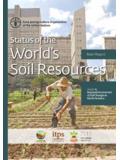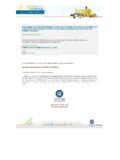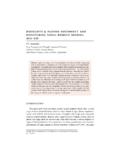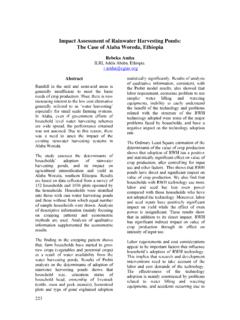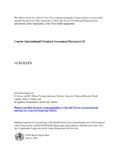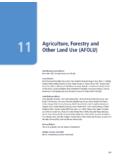Transcription of Status of the World’s Soil Resources. Chapter 9 …
1 Status of the World's Main Report soil Resources Chapter 9. regional assessment of soil Changes in Africa South of the Sahara FAO | Giuseppe Bizzarri INTERGOVERNMENTAL. TECHNICAL PANEL ON SOILS. Disclaimer and copyright Recommended citation: FAO and ITPS. 2015. Status of the World's soil Resources (SWSR) Main Report. Food and Agriculture Organization of the United Nations and Intergovernmental Technical Panel on Soils, Rome, Italy The designations employed and the presentation of material in this information product do not imply the expression of any opinion whatsoever on the part of the Food and Agriculture Organization of the United Nations (FAO) concerning the legal or development Status of any country, territory, city or area or of its authorities, or concerning the delimitation of its frontiers or boundaries. The mention of specific companies or products of manufacturers, whether or not these have been patented, does not imply that these have been endorsed or recommended by FAO in preference to others of a similar nature that are not mentioned.
2 The views expressed in this information product are those of the author(s). and do not necessarily reflect the views or policies of FAO. ISBN 978-92-5-109004-6. FAO, 2015. FAO encourages the use, reproduction and dissemination of material in this information product. Except where otherwise indicated, material may be copied, downloaded and printed for private study, research and teaching purposes, or for use in non-commercial products or services, provided that appropriate acknowledgement of FAO as the source and copyright holder is given and that FAO's endorsement of users'. views, products or services is not implied in any way. All requests for translation and adaptation rights, and for resale and other commercial use rights should be made via or addressed to FAO information products are available on the FAO website and can be purchased through Status of the World's soil Resources | Main Report Disclaimer and copyright 9 | regional assessment of soil Changes in Africa South of the Sahara regional Coordinator: Victor Chude (ITPS/Nigeria).
3 regional Lead Author: Ayoade Ogunkunle (Nigeria). Contributing Authors: Victor Chude (ITPS/Nigeria), Isaurinda Dos Santos (ITPS/Cape Verde), Tekalign Mamo (ITPS/Ethiopia), Garry Paterson (South Africa), Ndaye Soumare (Senegal), Liesl Wiese (South Africa), and Martin Yemefack (ITPS/Cameroon). Status of the World's soil Resources | Main Report regional assessment of soil Changes | 242. in Africa South of the Sahara | Introduction Land degradation in sub-Saharan Africa (SSA) is believed to be expanding at an alarming rate, accompanied by the lowest agriculture and livestock yields of any region in the world. While cereal production has increased marginally over the past two decades, more than 70 percent of this growth is due to area expansion rather than yield increases. The region also suffers from the world's highest rate of deforestation, with some countries having lost more than 10 percent of their forest cover in the five years up to 2009 (IFAD, 2009) and is most likely continuing at the same rate to this day.
4 There is a growing and long-standing recognition among both policy-makers and soil specialists that soil degradation is one of the root causes of declining agricultural productivity in sub-Saharan Africa and that, unless the process of degradation is controlled, many parts of the continent will suffer increasingly from food insecurity ( see Lal, 1990; UNEP, 1982). The consequences of allowing the productivity of Africa's soil resources to continue on its present downward spiral will be severe, not only for the economies of individual countries, but for the welfare of the millions of rural households across the continent who are dependent on agriculture (FAO, 1999). soil degradation is the decline in soil quality caused its improper use by humans, usually for agricultural, pastoral, industrial or urban purposes. soil degradation may be exacerbated by climate change and encompasses physical, chemical and biological deterioration. Examples of soil degradation cited by Charman and Murphy (2005) are: loss of organic matter; decline in soil fertility; decline in structural condition; topsoil loss and erosion; adverse changes in salinity, acidity or alkalinity; and the effects of toxic chemicals, pollutants and excessive flooding.
5 There is no consensus on the exact extent and severity of land degradation or its impacts in SSA as a whole (Reich et al., 2001; GEF, 2006). Lack of information and knowledge is considered to be one of the major obstacles for reducing land degradation, improving agricultural productivity, and facilitating the adoption of sustainable land management (SLM) among smallholder farmers (Liniger et al., 2011). The recent publication of the first soil Atlas of Africa has provided a first comprehensive overview of the soil resources of Africa (Jones et al., 2013). Four continental-scale studies have assessed the extent of soil degradation in Africa. A literature review by Dregne (1990) of 33 countries found compelling evidence of serious land degradation in sub-regions of 13. countries: Algeria, Ethiopia, Ghana, Kenya, Lesotho, Mali, Morocco, Nigeria, Swaziland, Tanzania, Tunisia, Uganda, and Zimbabwe. In another literature review, focused on drylands only, Dregne and Chou (1992).
6 Estimated that 73 percent of drylands were degraded and 51 percent severely degraded. They concluded that 18 percent of irrigated lands, 61 percent of rainfed lands, and 74 percent of rangelands located in SSA drylands are degraded. The Global assessment of soil Degradation (GLASOD) expert survey found that 65 percent of soils on agricultural lands in Africa had become degraded since the middle of the twentieth century, as had 31 percent of permanent pastures, and 19 percent of woodlands and forests (Oldeman, Hakkeling and Sombroek, 1991). Serious degradation affected 19 percent of agricultural land. A high proportion (72 percent) of degraded land was in drylands. The most widespread cause of degradation was water erosion, followed by wind erosion, chemical degradation (three-quarters from nutrient loss, the rest from salinization), and physical degradation. In terms of causes of degradation, overgrazing was responsible for half of all degradation, followed by agricultural activities, deforestation, and overexploitation.
7 Status of the World's soil Resources | Main Report regional assessment of soil Changes | 243. in Africa South of the Sahara The Land Degradation assessment in Drylands project (LADA) started in 2006 with the general purpose of creating the basis for informed policy advice on land degradation at global, national and local levels. This goal is being reached through the assessment of land degradation at different spatial and temporal scales in six countries and through the creation of a baseline at global level for future monitoring (FAO, 2010). Two of the six countries involved (Senegal and South Africa) are within SSA and national results are reported at the end of this Chapter . Lal (1995) calculated continent-wide soil erosion rates from water using data from the mid to late 1980s, and then used these rates to compute cumulative soil erosion for 1970-90. The highest erosion rates occurred in the Maghreb region of Northwest Africa, the East African highlands, eastern Madagascar, and parts of Southern Africa.
8 Excluding the percent of arid lands and deserts with no measurable water erosion, Lal found that the land area affected by erosion fell into the following six classes of erosion hazard: none, 8 percent; slight, 49. percent; low, 17 percent; moderate, 7 percent; high, 13 percent; and severe, 6 percent. Soils host the majority of the world's biodiversity and healthy soils are essential to securing food and fibre production. Soils assure an adequate and clean water supply over the long term, as well as providing cultural functions. Ecosystem services provided by soils are integral to the carbon and water cycles. Major increases in agricultural production have been associated with different kinds of soil degradation, especially since the agricultural growth came in part from extensive clearing of new agricultural lands. Yet, even with this expansion, arable land per capita in Africa declined from just under ha in 1950 to just under ha in 1990 (FAO, 1993). During this time period, yield increases on land already in production thus contributed far more to the total production.
9 For example, more than 90 percent of the growth in developing country cereal production between 1961 and 1990 came from yield growth (World Bank, 1992). Agricultural expansion and yield growth at such a scale is inevitably associated with some degradation of soil resources. However, the type and extent of degradation vary in the different ecological/farming systems (IFPRI, 1999). | Stratification of the Region The region is diverse in terms of relief, climate, lithology, soils and agricultural systems. A combination of some of these have been used to stratify the region into agro-ecological zones (AEZs) (Fischer et al., 2002;. Global HarvestChoice, 2010). Table shows the AEZs into which the region has been grouped and some of their characteristics, while Figure shows the distribution of the AEZs in the region. | Arid zone The arid zone occupies 36 percent of the land area of SSA, most of which is in West and East Africa. Rainfall is low and extremely variable in this zone.
10 The annual rainfall of less than 500 mm, combined with high temperatures and consequent high rates of evapotranspiration, make this zone capable of sustaining plant life for less than 90 plant growth days (or length of growing season). Status of the World's soil Resources | Main Report regional assessment of soil Changes | 244. in Africa South of the Sahara Figure | Agro-ecological zones in Africa South of the Sahara. Source: Otte and Chilonda, 2002. Table | Characteristics and distribution of agro-ecological zones in Africa Source: ILCA, 1987, after Jahnke, 1982. a pgd = plant growth days; bAreas with mean daily temperature during the growing period less than 20 C; c: = not available. Area (percent). Rainfall Area Zone Definition range West Central East Southern of zone (mm) Africa Africa Africa Africa (percent). Arid <90 pgda 0 500 54 1 52 20 36. 90 180 500 . Semi-arid 20 7 18 34 18. pgd 1000. 180 270 1000 . Sub-humid 16 29 16 38 22. pgd 1500. Humid >270 pgd 1500+ 10 59 2 7 19.










